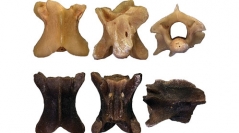

 Comptes Rendus Palevol
18 (7) - Pages 801-815
Comptes Rendus Palevol
18 (7) - Pages 801-815I here describe new fossil remains of lizards and snakes from the late Miocene of Pikermi, near Athens, Greece. This classical locality, known since at least the middle of the 19th century, has yielded over the decades abundant mammal fossils, whereas squamate remains have been confined to early discoveries of Varanus remains during the 19th century. The first specimen among these varanid fossils, a large vertebra described by Albert Gaudry during the 1860s, represents also one of the earliest discoveries of a fossil monitor lizard worldwide. Nevertheless, this historically important specimen has only been briefly described and its so far only available images were the original lithographs and subsequent sketches of two only of its views. I here describe this specimen in detail and provide photographs of all its standard views. The additional squamate remains from the Pikermi area are fragmentary. Nevertheless, they document the presence in Pikermi of other lizard groups, such as lacertids and probable anguines, while snakes are described for the first time. Among the snake fossils, probable erycines and colubrids are identified; if indeed an erycine, this would be the oldest occurrence of that group in the Eastern Mediterranean, thus extending back its stratigraphic range in the area by several million years.
Squamata, lizards, snakes, Miocene, Pikermi, Greece, systematics